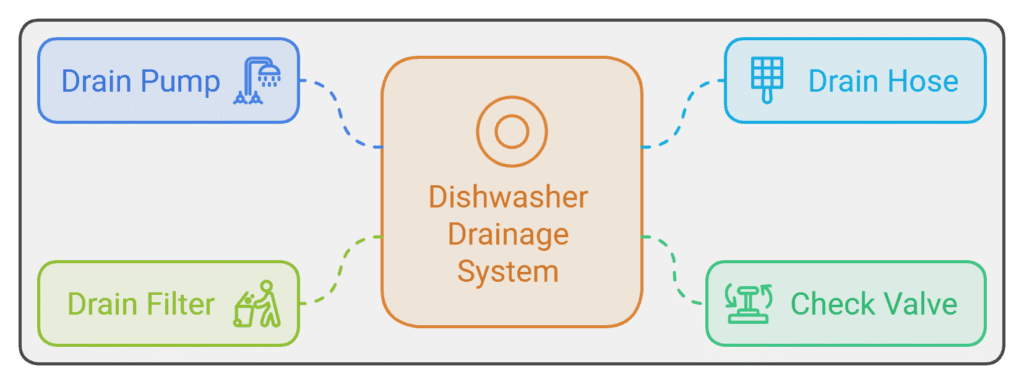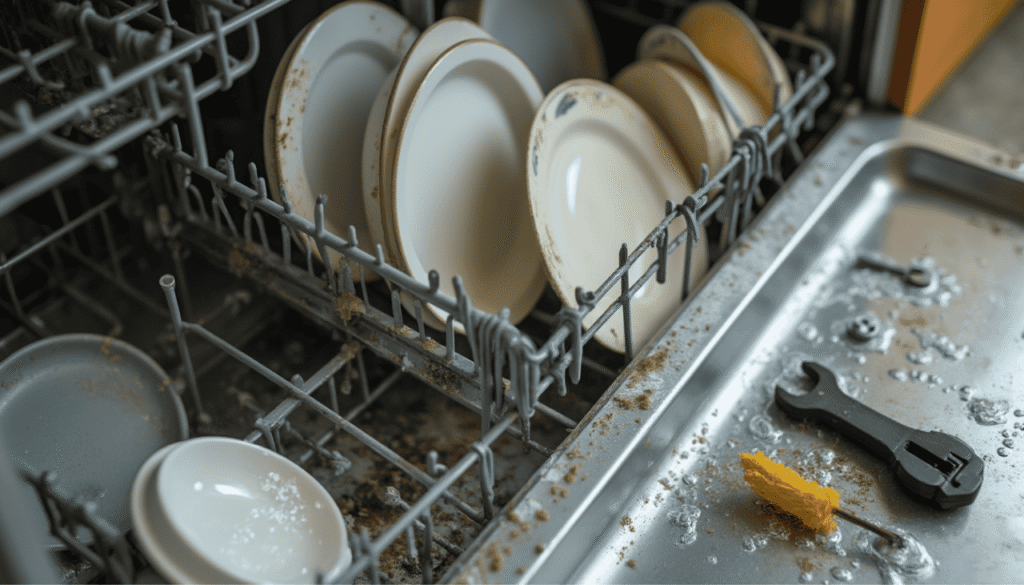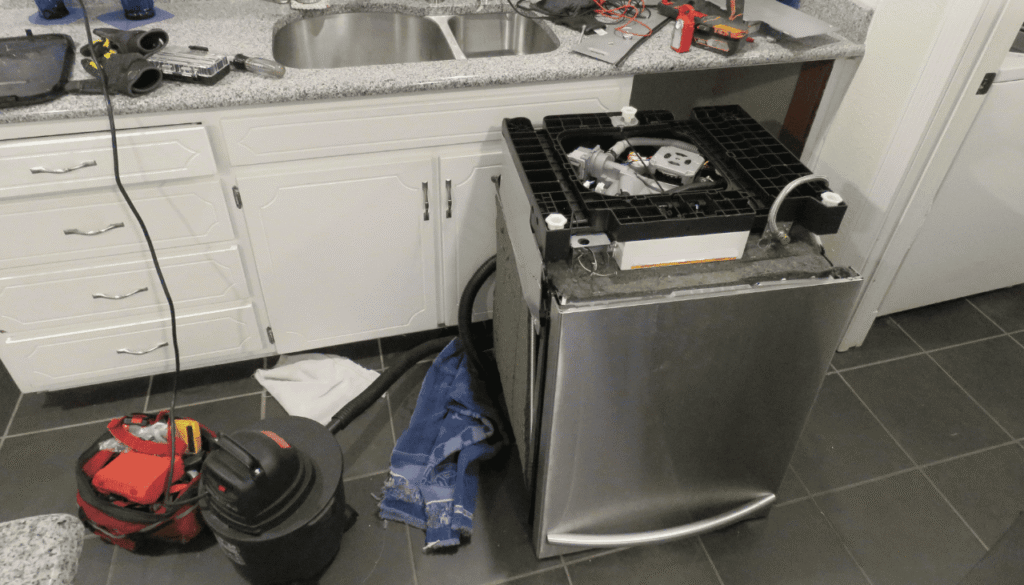A dishwasher not draining properly can be caused by several factors, including clogged filters, blocked drain hoses, faulty drain pumps, or obstructed garbage disposals. Common solutions involve cleaning the filter and drain hose, checking for kinks, and ensuring proper installation. To prevent drainage issues, regularly clean the dishwasher, avoid overloading, and dispose of food scraps before loading dishes. Proper maintenance includes inspecting components, using appropriate detergents, and addressing problems promptly. If DIY troubleshooting doesn’t resolve the issue, a professional diagnosis may be necessary. Understanding the drainage system’s components and function can help identify and solve problems efficiently, ensuring ideal dishwasher performance.
Key Takeaways
- Clogged filters, blocked drain hoses, and faulty drain pumps are common causes of dishwasher drainage issues.
- Clean filters, unclog drain hoses, and clear garbage disposal connections to resolve most drainage problems.
- Regular maintenance, including cleaning filters and proper loading, prevents debris accumulation and drainage issues.
- Check for and address unusual noises, standing water, or extended cycle times as early signs of drainage problems.
- Ensure proper dishwasher installation, including correct levelling and appropriate plumbing connections, for optimal drainage performance.
Understanding Dishwasher Drainage Systems

The dishwasher drainage system consists of several key components, including the drain pump, drain hose, and check valve. The drain filter also plays an indispensable role in capturing food scraps and maintaining cleanliness within the system.
During the drainage cycle, water is forcefully expelled from the dishwasher tub through these components and into the household plumbing system. Understanding the drainage mechanism and its potential failure points, such as clogs, faulty pumps, or kinked hoses, is essential for diagnosing and resolving dishwasher draining issues.
Components of a Dishwasher’s Draining Mechanism
The main components include:
- Drain filter
- Drain pump
- Drain hose
- Air gap
- Sink drain and p-trap
These elements work together to remove water and food particles from the dishwasher. The filter traps debris, the pump forces water out, the hose carries it away, and the air gap prevents backflow.
If you encounter a clogged drain hose, it is necessary to address the issue promptly to prevent water from backing up into the dishwasher. Regular maintenance of these components guarantees efficient drainage and prevents standing water problems.
How the Drainage Cycle Works
Efficiency in dishwasher drainage relies on a well-orchestrated cycle that removes water and debris from the appliance. The drain valve opens, activating the motor and impeller. As the pump operates, you’ll hear a distinct draining noise.
Proper water supply is vital for both cleaning and draining processes, as insufficient water can lead to drainage issues. The check valve prevents backflow, ensuring unidirectional water movement. Pump efficiency affects drain cycle duration, typically lasting 2-3 minutes.
Understanding this process helps us troubleshoot drainage issues effectively.
Common Points of Failure in Dishwasher Drainage
Dishwasher drainage systems, despite their seemingly simple function, can experience various points of failure. Common issues include:
- Clogged drain or filter requiring cleaning
- Faulty drain pump needs replacement
- Blocked garbage disposal connection
- Kinked or damaged drain hose
- Pump impeller obstruction
Poor drainage can often be a symptom of cleaning issues that extend beyond just the drainage system. Addressing these problems promptly can prevent more serious malfunctions and guarantee your dishes come out sparkling clean.
These problems often result in standing water and poor drainage. Regular maintenance, including filter cleaning, hose inspection, and pump cleaning, can prevent many blockages and maintain optimal dishwasher performance.
Identifying Drainage Issues
Identifying drainage issues in a dishwasher requires careful observation of specific symptoms. Key indicators include standing water at the bottom of the tub, unusual noises during the drain cycle, and dishes remaining wet or covered in residue after a complete cycle.
While these signs typically point to drainage problems, it’s important to note that some symptoms, like water accumulation, could also indicate a leaking dishwasher, which requires a different troubleshooting approach. Proper diagnosis of drainage problems is essential, as these issues can greatly impact the appliance’s cleaning effectiveness and potentially lead to unhygienic conditions if left unaddressed.
Signs of a Dishwasher Not Draining Properly
Recognizing the signs of a dishwasher not draining properly is crucial for maintaining the appliance’s efficiency and preventing potential water damage. Common indicators include:
- Standing water at the bottom after a cycle
- Dishes remaining wet or not fully clean
- Unusual gurgling or humming noises
- Extended cycle duration
- Visible clogs in the filter or drain hose
In some cases, a dishwasher may experience a never-ending cycle, which can indicate drainage issues or other underlying problems. If your dishwasher keeps running without stopping, it’s indispensable to investigate the cause promptly.
These signs often point to issues within the drainage system, such as a clogged drain, pump failure, or blockages. Addressing these problems promptly ensures perfect dishwasher performance.
Differentiating Drainage Problems from Other Dishwasher Malfunctions
While drainage issues are common, they can often be mistaken for other dishwasher malfunctions. To accurately identify drainage problems, inspect for these key indicators:
| Symptom | Drainage Issue | Other Malfunction |
|---|---|---|
| Standing water | Obstruction or pump failure | Cycle interruption |
| Slow draining | Clogged drain or plumbing | Weak wash cycle |
| Foul odor | Food debris in drain | Detergent buildup |
| Gurgling sounds | Air in drainage system | Motor problems |
| Wet dishes | Incomplete drain cycle | Heating element failure |
Proper diagnosis guarantees effective unclogging and cleaning of the drain system.
Impact of Drainage Issues on Dishwasher Performance and Hygiene
Drainage issues can substantially impact a dishwasher’s performance and overall hygiene. Poor drainage leads to:
- Accumulation of food particles, grease buildup, and soap scum
- Unpleasant odors and bacterial growth
- Reduced cleaning efficiency and spotty dishes
- Potential damage to dishwasher components
- Risk of water leakage and floor damage
Cleaning issues in dishwashers often stem from drainage problems, which can significantly affect the appliance’s ability to thoroughly clean dishes. When water doesn’t drain properly, it can leave behind residue and contaminants, compromising the cleaning process. Improper loading, overloading, wrong detergent, and incorrect cycle selection can exacerbate these problems. Regular maintenance and addressing drainage issues promptly are essential for paramount dishwasher performance and hygiene.
DIY Troubleshooting and Fixes
To address dishwasher drainage issues, homeowners can perform several troubleshooting steps. Begin by examining and cleaning the dishwasher’s filters, which often accumulate debris and impede water flow.
If your dishwasher isn’t cleaning properly, you may need to check for other issues beyond drainage problems. Next, inspect the drain hose for kinks, blockages, or improper installation, and clear any obstructions found. Finally, utilize appropriate cleaning agents to dissolve buildup and maintain proper drainage, following manufacturer recommendations for product selection and application.
Step-by-Step Guide to Checking and Cleaning Filters
Filters play an important role in your dishwasher’s drainage system. Regular maintenance involves thoroughly cleaning the filter to guarantee ideal performance.
Water supply issues can also contribute to drainage problems, so it’s important to check both aspects when troubleshooting.

Follow these steps to inspect and clean your dishwasher’s filter:
- Locate and remove the filter
- Rinse under running water
- Scrub gently with a soft brush
- Inspect for damage or wear
- Reinstall the clean filter
After cleaning, run an empty cycle to rinse the dishwasher interior. Regularly performing this task prevents clogs and maintains proficient drainage.
Inspecting and Clearing the Drain Hose
Inspecting the drain hose is a pivotal step in diagnosing and resolving dishwasher drainage issues. Check the drain hose for kinks, blockages, or damage that may impede water flow.
While inspecting the drain hose, also verify that the water supply is adequate and not contributing to drainage problems. If the water supply is insufficient, it can affect the overall performance of the dishwasher, including its ability to drain properly.
Guarantee proper hose diameter and clog resistance to preserve ideal flow rate during the drain cycle. Assess hose accessibility for easy cleaning and flushing. Regular inspection and cleaning frequency can prevent future drainage problems, keeping your dishwasher running efficiently.
Proper Use of Cleaning Agents to Address Drainage Problems
Selecting appropriate cleaning agents is crucial when addressing dishwasher drainage problems. These effective options can help clear clogs and enhance circulation:
- White vinegar: Dissolves mineral buildup
- Baking soda: Neutralizes odours and breaks down grease
- Citric acid: Removes hard water deposits
- Enzymatic cleaner: Targets organic matter
- Commercial dishwasher cleaner: Thorough sanitization
If you notice a burning smell coming from your dishwasher, it may indicate a more serious issue that requires professional attention. Regular cleaning can help prevent such problems from occurring.
Use these agents regularly to maintain ideal drain pump performance and prevent future drainage issues. Always follow manufacturer instructions for proper application and safety.
Advanced Diagnostics and Repairs
Advanced diagnostics for a non-draining dishwasher involve testing the drain pump and motor for functionality and examining the garbage disposal connection for potential blockages. Certified technicians can quickly diagnose and address these issues, ensuring a fast and reliable repair process.
These procedures require specific tools and technical knowledge to accurately assess and address underlying issues. If these advanced troubleshooting steps prove challenging or unsuccessful, it may be necessary to consult a professional appliance technician for expert diagnosis and repair.
Testing the Drain Pump and Motor
A malfunctioning drain pump or motor can be the culprit behind a dishwasher’s failure to drain properly. While this issue differs from leaking dishwasher problems, the diagnostic process can be similar.
Regular maintenance and inspection can help prevent both drainage and leakage issues. To test the drain pump and assess the dishwasher drainage system, follow these steps:
- Listen for motor hum during the operation
- Check for vibration indicating pump strength
- Inspect for visible defects or breakdown
- Test electrical continuity
- Measure the resistance with a multimeter
If any issues are detected, consult a professional for repair or replacement to guarantee favourable performance.
Addressing Issues with the Garbage Disposal Connection
Many dishwashers are connected to garbage disposals, which can sometimes lead to drainage issues. To address this, inspect the garbage disposal for clogs and perform regular garbage disposal maintenance.
If you hear loud noises coming from your dishwasher, it could be related to the disposal connection or other drainage problems. Guarantee a proper high-loop connection or direct-connect setup to prevent backflow. Check the drain pump assembly for obstructions and confirm sufficient drain volume.
If discharge problems persist, consider professional intervention to assess the connection between the dishwasher and disposal for ideal drainage performance.
When to Call a Professional Appliance Technician
Persistent drainage issues that resist basic troubleshooting often necessitate the expertise of a professional appliance technician. These professionals can properly diagnose and efficiently repair complex problems, ensuring your dishwasher’s ideal performance.
Non-responsive dishwashers may also require professional attention, as they can indicate serious electrical or mechanical issues. Addressing these problems promptly can prevent further damage to your appliance.
When to seek professional assistance:
- Faulty pump or valve issues
- Electrical malfunctions
- Clogged drain lines requiring specialized tools
- Persistent water evacuation problems
- Safety concerns during DIY attempts
Licensed technicians carefully service your appliance, providing peace of mind and avoiding potential hazards associated with amateur repairs.
Preventive Maintenance and Best Practices
Implementing a systematic approach to dishwasher maintenance is essential for preventing drainage issues. Regular cleaning routines, including filter maintenance and periodic hot water cycles, effectively minimize debris accumulation and flush out residual buildup.
Utilizing multiple spray zones and flexible wash arms can enhance cleaning coverage and reduce the likelihood of food particles clogging the drain. Proper loading techniques, coupled with frequent operation and monthly inspections of key components, contribute to maintaining ideal drainage function over the long term.
Establishing a Regular Cleaning Routine for Your Dishwasher
A well-maintained dishwasher operates efficiently and prevents drainage issues. Establishing a regular cleaning routine is indispensable for ideal performance. Regular cleaning also helps identify potential problems early and can prolong your dishwasher’s lifespan.
Proper water temperature settings are pivotal for effective cleaning and drying. Consider these key practices:
- Implement proper pre-rinsing habits
- Perform monthly manual deep cleaning
- Run self-cleaning cycles as recommended
- Inspect and clean filters regularly
- Monitor cycle length and rinse efficiency
Proper Loading Techniques to Prevent Drainage Issues
To prevent drainage issues, proper loading techniques are crucial for ideal dishwasher performance. Whether you own a Bosch, Whirlpool, KitchenAid, Maytag, or Samsung appliance, optimizing load placement guarantees smooth water flow and drainage.
Placing plates and bowls towards the center of the dishwasher improves water access and promotes better drying. Furthermore, make certain utensils are placed in designated holders to maximize cleaning efficiency. Position large items on the sides to avoid blocking spray arms.
Face dirty surfaces toward the center for maximum cleaning effectiveness. Arrange utensils in the designated basket with handles down for thorough washing and easy unloading.
Long-term Strategies for Maintaining Optimal Drainage Function
Maintaining ideal drainage function in your dishwasher requires a proactive approach to preventive maintenance and adherence to best practices.
To guarantee efficient water retention and recirculation system performance:
- Clean the removable cylinder filter regularly
- Operate the dishwasher weekly
- Inspect the corrugated drain hose
- Avoid overloading
- Use appropriate detergent
Proper water heating is vital for effective cleaning and drainage. If your dishwasher isn’t heating water correctly, it can lead to poor cleaning results and potential drainage issues.
These strategies minimize tool requirements and optimize energy efficiency. Consider standby power consumption and Energy Star rating when selecting a new dishwasher for long-term drainage performance.












